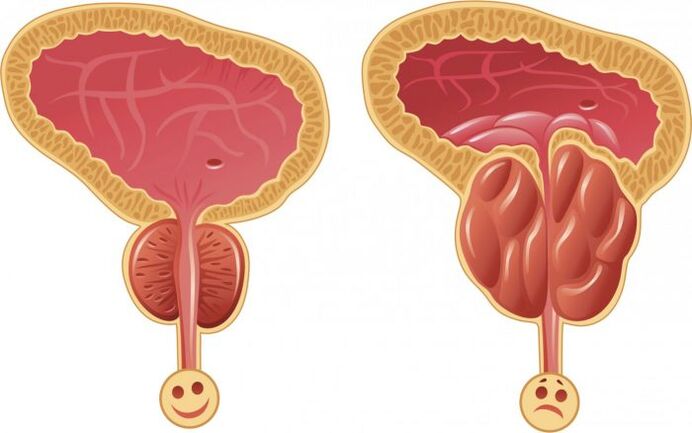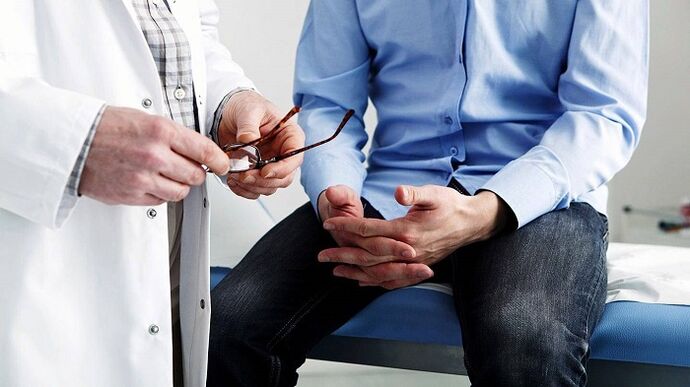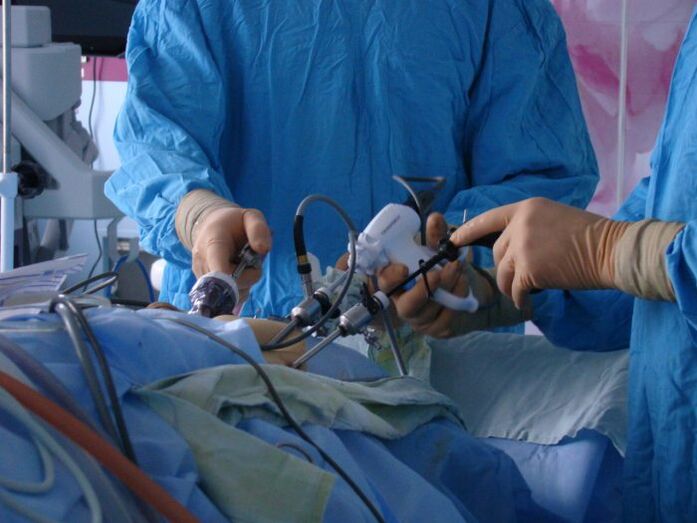Pain when urinating, a burning sensation in the urethra, erectile dysfunction, and frequent trips to the toilet are symptoms of an inflammatory process in the prostate. What is prostatitisThe disease is multifactorial, the etiology is due to a combination of provoking factors that lead to inflammation. In medical practice, pathology is classified according to its course, pathogenesis and other aspects. Let us consider what causes lead to the disease, what symptoms it manifests and how it is treated.
What is prostatitis

To understand what prostatitis in men is, you need to know what the glandular organ is. The prostate is a male internal organ. In appearance it resembles a "heart" or a "chestnut". Ancient doctors called this organ "the second male heart".
The functionality of the glandular organ is as follows:
- Making a secret, which is a liquid with a specific smell;
- Protecting the prostate from infection;
- Maintaining full erectile function;
- Synthesis of the hormone testosterone;
- Ensure normal urination.
The production of secretions in the prostate is constantly monitored. In healthy representatives of the stronger sex, it enters the urethra during sperm secretion. Prostate secretion increases sperm volume and helps maintain the vital activity of the sperm.
For your information, prostatitis is a common disease diagnosed in 80% of men, 30% of whom are diagnosed between the ages of 20 and 40. According to static studies, pathology is observed in every tenth man.
If an ultrasound scan shows swelling of the prostate and foci of inflammation, it is prostatitis. In most clinical pictures, the inflammatory process proceeds with the formation of concretions. The male organ is surrounded by the urethral canal and vas deferens, and edema leads to compression of the ureter. As a result, the dominant symptom of the disease is revealed - problems with urination - pain, cramps, burning sensation.
When an inflammatory process occurs, the qualitative and quantitative composition of prostate juice changes, as a result of which sexual desire decreases, erection worsens, and potency decreases.
Causes and symptoms of prostatitis

Speaking of prostatitis, it is impossible to pinpoint the exact cause of the inflammatory process. Many doctors agree that the etiology is based on a combination of certain factors.
Prostatitis occurs for the following reasons:
- Infectious pathologies that are transmitted during sexual intercourse.
- Violation of blood circulation in the pelvic organs. This leads to an inactive lifestyle, tight underwear, jeans.
- Injury to the organs of the perineum, which leads to poor blood circulation.
- Frequent hypothermia, the presence of chronic pathologies of the reproductive system.
- Hormonal imbalance, irregular sex life, prolonged abstinence.
- Inflammation in the rectum can provoke the development of prostatitis.
- Constipation of a chronic nature.
- Decreased immune status. Primary sources are chronic stress, unhealthy eating habits, alcohol consumption, smoking, and an unbalanced diet.
- Urological infections such as gonorrhea.
In fact, there are many reasons for the beginning of the pathological process. Only by establishing the provoking factor can one speak of a favorable prognosis.
Prostatitis is acute and chronic. In the first case, a man's body temperature increases significantly, frequent visits to the toilet are observed, accompanied by a severe pain syndrome and weak pressure of the urine stream. Often associated with such a clinic is a burning sensation in the perineum, painful sensations in the rectum when defecating.
Worth knowing:with purulent inflammation of the prostate and opening of the abscess, there is an outflow of purulent masses from the urethral canal or rectum.
In the chronic course of the pathology, the symptoms are not very pronounced. Patients are diagnosed with the following clinic:
- Low fever that does not decrease for a long time;
- Pubic pain;
- Problems with bowel movements;
- Constant fatigue, unreasonable nervousness and irritability.
Difficulty urinating is a particular danger against the background of inflammation in the glandular organ. Without proper treatment, it can lead to serious consequences - acute urinary retention.
Types of prostatitis

So, in order to find out everything about prostatitis in men, you need to take into account the forms of the disease. First of all, there is an acute and chronic inflammatory process. The name "sharp" speaks for itself. This indicates that there is an inflammatory process caused by infection. In most cases microbes, less often the simplest microorganisms or fungi.
In the absence of therapy for an acute form of the pathology, it is converted into a chronic course, there may be a complication in the form of benign hyperplasia of the glandular organ. Symptoms are not expressed acutely, which is the danger of this type of disease.
The etiology of chronic prostatitis is due to pathogenic microorganisms and other causes. For example, the phenomenon of stagnation in the pelvic organs, age-related changes.
Important:Bacterial prostatitis is acute and chronic. Inflammation is caused by bacteria - Escherichia coli and Pseudomonas aeruginosa, enterococci, Klebsiella. Most often this type is diagnosed in men between the ages of 20 and 40 years, compared to other types of prostatitis it occurs in 5-10% of the clinical pictures.
Other types of inflammation in the prostate:
- The stony form of prostatitis is characterized by an inflammatory process that arises from the formation of stones in the prostate. Most often it is diagnosed in patients of the older age group who have neglected drug treatment of the acute form. Neglected tartar disease leads to impaired reproductive function, infertility, impotence, adenomas, and other complications.
- The stagnant form of the disease is most often chronic, the etiology is not infectious. The main reason is blood congestion in the pelvic organs, for example in the case of circulatory disorders in the pelvis or stagnation of prostate secretions due to irregular intimate life.
- An infectious disease develops due to the activity of pathogenic bacteria, tests show E. coli in most of the images. There is an acute and chronic course, the clinic is similar to the type of bacteria.
- A purulent form is the most dangerous type of pathology. In medicine, purulent prostatitis is divided into other types. Catarrhal develops against the background of a weak immune status along with the progression of a sore throat and flu. Follicular prostatitis is already the second stage of a purulent disease; there is a discharge of pus into the prostate, which is accompanied by a severe pain syndrome and high body temperature. The parenchymal form is a severe form that requires timely treatment. An abscess of the tissues of the glandular organ is called an abscess disease; Therapy should be started immediately as there is a risk of sepsis.
The treatment regimen for inflammation in the prostate is due to a certain type of pathology, or it can differ significantly. You can combine medication with physical therapy procedures and alternative therapies.
Diagnosis of prostatitis

To diagnose inflammation, the doctor collects the patient's medical history, and then prescribes laboratory and instrument research methods. They enable error-free diagnosis based on certain indicators.
Fact:You can suspect prostatitis with a rectal exam of the prostate. Anterior rectal pain and an increase in organ size are characteristic signs of inflammation.
After rectal palpation, the following diagnostic methods are prescribed:
- Ultrasound examination reveals the size of the organ, symptoms of the inflammatory process, changes in the structure of soft tissues;
- Examination of the prostate secretion allows you to identify its composition and deviations from the norm;
- Examination of urine and a smear from the mucous membrane of the urethra will help determine infectious diseases that are transmitted during sexual intercourse;
- Assessment of the hormonal status. An excess of hormonal substances can lead to pathological proliferation of tissues of the glandular organ, and a decrease in the concentration of hormones can lead to malfunction.
A specialist diagnosis is not about the inflammation itself, as it can be detected by palpating the prostate, but about the causes of the disease. Finally, by determining the correct provoking factor, you can prescribe an effective course of therapy.
Methods of treating diseases

Treatment for prostatitis is always a complex process that involves taking various medications. It is not forbidden to use traditional therapy methods with the permission of the attending physician.
Therapeutic activities include:
- Antibacterial pills, immunostimulating drugs, anti-inflammatory drugs. Dosage, frequency and duration of application are determined individually. Medicines can be bought from the pharmacy, many of which require a doctor's prescription.
- Physiotherapeutic manipulations - the use of a magnetic field, leech therapy, ultrasound and laser treatment.
- Massage the prostate. It allows you to strengthen the reproductive system, normalize blood flow to the prostate and pelvic organs.
Traditional therapy methods are decoctions and infusions based on medicinal herbs. Patient reports indicate the high therapeutic efficacy of red root, licorice and marshmallow rhizomes.
Important: To cure prostatitis, you need to strictly adhere to the prescribed treatment regimen. Self-administration of drugs, even the most effective, may not produce the desired result. There is no single therapeutic tactic: What helps one patient is harmful to the second patient.
Preventive measures
Prostatitis is one of those pathologies that is easier to prevent. Doctors have long developed preventive measures to rule out the disease. Prevention is primary and secondary. In the second case, the recurrence of a chronic disease should be prevented.
Preventive measures:
- Physical activity;
- Regular sexual intercourse;
- Exclusion from promiscuous sexual intercourse;
- Timely treatment of all accompanying pathologies;
- Check-ups by a urologist;
- Rational nutrition, rejection of bad eating habits.
Prostate inflammation prevention does not require a lot of time and investment, and the effectiveness of the measures is undeniable.
Prostatitis is a common condition. The self-healing rate is very low. The lack of adequate therapy leads to a chronic course of the disease, which periodically worsens and can provoke organ hyperplasia or oncology.

































